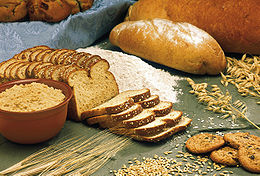Bread
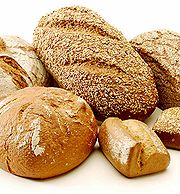
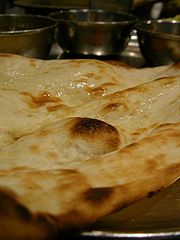
| Nutritional value per 100 g (3.5 oz) | |
|---|---|
| Energy | 1,113 kJ (266 kcal) |
| Carbohydrates | 51 g |
| Dietary fiber | 2.4 g |
| Fat | 3 g |
| Protein | 8 g |
| Vitamin A | 0 IU |
| Thiamine (Vit. B1) | 0.5 mg (38%) |
| Riboflavin (Vit. B2) | 0.3 mg (20%) |
| Niacin (Vit. B3) | 4 mg (27%) |
| Folate (Vit. B9) | 111 μg (28%) |
| Vitamin B12 | 0 μg (0%) |
| Vitamin K | 3.1 μg (3%) |
| Calcium | 151 mg (15%) |
| Iron | 3.74 mg (30%) |
| Magnesium | 23 mg (6%) |
| Sodium | 681 mg (30%) |
| Percentages are relative to US recommendations for adults. |
|
| Nutritional value per 100 g (3.5 oz) | |
|---|---|
| Energy | 1,029 kJ (246 kcal) |
| Carbohydrates | 46 g |
| Dietary fiber | 7 g |
| Fat | 4 g |
| Protein | 10 g |
| Thiamine (Vit. B1) | 0.4 mg (31%) |
| Riboflavin (Vit. B2) | 0.2 mg (13%) |
| Niacin (Vit. B3) | 4 mg (27%) |
| Sodium | 527 mg (23%) |
| Percentages are relative to US recommendations for adults. |
|
Bread is a staple food prepared by cooking a dough of flour and water and frequently additional ingredients. Doughs are usually baked, but in some cuisines breads are steamed, fried, or baked on an unoiled skillet. It may be leavened or unleavened. Salt, fat and leavening agents such as yeast and baking soda are common ingredients, though bread may contain other ingredients, such as milk, egg, sugar, spice, fruit (such as raisins), vegetables (such as onion), nuts (such as walnuts) or seeds (such as poppy seeds). Bread is one of the oldest prepared foods, dating back to the Neolithic era, and is referred to colloquially as the "Staff of life". The development of leavened bread can probably also be traced to prehistoric times.
Fresh bread is prized for its taste, aroma, quality, appearance and texture. Retaining its freshness is important to keep it appetizing. Bread that has stiffened or dried past its prime is said to be stale. Modern bread is sometimes wrapped in paper or plastic film, or stored in a container such as a breadbox to reduce drying. Bread that is kept in warm, moist environments is prone to the growth of mold. Bread kept at low temperatures, in a refrigerator for example, will develop mold growth more slowly than bread kept at room temperature, but will turn stale quickly due to retrogradation.
The soft, inner part of bread is known to bakers and other culinary professionals as the crumb, which is not to be confused with small bits of bread that often fall off, called crumbs. The outer hard portion of bread is called the crust.
Contents |
Etymology
The word itself, Old English bread, is common in various forms to many Germanic languages; such as Frisian brea, Dutch brood, German Brot, Swedish bröd, Norwegian and Danish brød; it has been claimed to be derived from the root of brew. However, it may be connected with the root of break, for its early uses are confined to broken pieces, or bits of bread, the Latin crustum, and it was not until the 12th century that it took the place—as the generic name for bread—of hlaf (𐌷𐌻𐌰𐌹𐍆𐍃 [hlaifs] in Gothic: modern English loaf), which appears to be the oldest Teutonic name; Old High German hleib and modern German Laib, or Finnish leipä, Estonian leib, and Russian хлеб (khleb) are similar (all are derived from the Indo-European word for "loaf").
History
Bread is one of the oldest prepared foods, dating back to the Neolithic era. The first bread produced was probably a cooked version of a grain-paste, made from ground cereal grains and water, and may have been developed by accidental cooking or deliberate experimentation with water and grain flour. Yeast spores are ubiquitous, including the surface of cereal grains, so any dough left to rest will become naturally leavened.[1] There were multiple sources of leavening available for early bread. Airborne yeasts could be harnessed by leaving uncooked dough exposed to air for some time before cooking. Pliny the Elder reported that the Gauls and Iberians used the foam skimmed from beer to produce "a lighter kind of bread than other peoples." Parts of the ancient world that drank wine instead of beer used a paste composed of grape juice and flour that was allowed to begin fermenting, or wheat bran steeped in wine, as a source for yeast. The most common source of leavening, however, was to retain a piece of dough from the previous day to use as a form of sourdough starter.[2]
A major advance happened in 1961 with the development of the Chorleywood Bread Process, which used the intense mechanical working of dough to dramatically reduce the fermentation period and the time taken to produce a loaf. The process, whose high-energy mixing allows for the use of inferior grain, is now widely used around the world in large factories.
Recently, domestic breadmakers that automate the process of making bread have become popular in the home.
Cultural and political importance of bread
As a foodstuff of great historical and contemporary importance, in many cultures in the West and Near and Middle East bread has a significance beyond mere nutrition. The Lord's Prayer, for example, contains the line "Give us this day our daily bread"; here, "bread" is commonly understood to mean necessities in general. Bread is also significant in Christianity as one of the elements (alongside wine) of the Eucharist; see sacramental bread. The word companion comes from Latin com- "with" + panis "bread". The Roman poet Juvenal satirised superficial politicians and the public as caring only for "panem et circenses" (bread and circuses). In Israel the most usual phrase in work related demonstrations is "lekhem, avoda" [bread, work], and during the 1950s, the beatnik community used the term bread as a euphemism for money. In Cockney Rhyming Slang, bread means money and is derived from the phrase bread and honey.[3] The word bread is now commonly used around the world in English speaking countries as a synonym for money (as also is the case with the word dough.)
The cultural importance of "bread" goes beyond slang, however, to serve as a metaphor for basic necessities and living conditions in general. A "bread-winner" is a household's main economic contributor and has little to do with actual bread-provision, for example. This also goes along with the phrase "putting bread on the table". A remarkable or revolutionary innovation is often referred to as "the greatest thing since sliced bread". In the USSR in 1917, Lenin and his fellow Bolsheviks promised "Peace, Land, and Bread."[4][5] The term "breadbasket" is often used to denote an agriculturally productive region. In Slavic cultures bread and salt is offered as a welcome to all guests. In Egyptian Arabic, the word for life, 'ayish, is also the colloquial word for bread (the formal is 'khoubz'). In India, life's basic necessities are often referred to as "roti, kapra aur makan" [bread, cloth and house].
The political significance of bread is considerable. In Britain in the nineteenth century the inflated price of bread due to the Corn Laws caused major political and social divisions, and was central to debates over free trade and protectionism. The Assize of Bread and Ale in the thirteenth century demonstrated the importance of bread in medieval times by setting heavy punishments for short-changing bakers, and bread appeared in the Magna Carta a half-century earlier.
Types
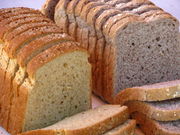
Bread is the staple food in Europe, European-derived cultures such as the Americas, and the Middle East/North Africa, as opposed to East Asia whose staple is rice. Bread is usually made from a wheat-flour dough that is cultured with yeast, allowed to rise, and finally baked in an oven. Owing to its high levels of gluten (which give the dough sponginess and elasticity), common wheat (also known as bread wheat) is the most common grain used for the preparation of bread, but bread is also made from the flour of other wheat species (including durum, spelt and emmer), rye, barley, maize (or corn), and oats, usually, but not always, in combination with wheat flour. Although common wheat is best suited for making highly risen white bread, other wheat species are capable of giving good black bread. Spelt bread (Dinkelbrot) continues to be widely consumed in Germany, and emmer bread was a staple food in ancient Egypt. Canadian bread is known for its heartier consistency due to high protein levels in Canadian flour.
- White bread is made from flour containing only the central core of the grain (endosperm).
- Brown bread is made with endosperm and 10% bran. It can also refer to white bread with added colouring (often caramel colouring) to make it 'brown'; commonly labeled in America as "Wheat" bread (as opposed to "Whole Wheat" bread.)[6]
- Wholemeal bread contains the whole of the wheat grain (endosperm and bran). It is also referred to as 'whole grain' or 'whole wheat' bread, especially in North America.
- Wheat germ bread has added wheat germ for flavoring.
- Whole grain bread can refer to the same as 'wholemeal bread', or to white bread with added whole grains to increase its fibre content (i.e. as in "60% whole grain bread").
- Roti is a whole wheat based bread eaten in South Asia. Chapatti is a larger variant of Roti. Naan is a leavened equivalent to these.
- Granary bread is bread made using flaked malted wheat grains malt. Trademarked to Hovis, it is made from white or brown flour and flaked malted wheat grains. The standard malting process is modified to maximise maltose / sugar content but minimise residual alpha amylase content. Other flavour components are imparted from partial fermentation due to the particular malting process used and to Maillard reactions on flaking / toasting.
- Rye bread is made with flour from rye grain of variable levels. It is higher in fiber than many common types of bread and is often darker in color and stronger in flavor. In Scandinavia, Germany, Finland, the Baltic States, and Russia, rye is a popular type of bread.
- Unleavened Bread or Matzah used for the Jewish feast of Passover, does not include yeast, thus it does not rise.
- Sourdough bread is made with a starter.
- Researchers at the Agricultural Research Service are inventing new whole-grain oat and barley breads that offer more antioxidants and fibers than traditional whole-grain breads. [3]
Quick breads
Quick breads usually refer to breads chemically leavened, usually with both baking powder and baking soda, and a balance of acidic ingredients, and alkaline ingredients. Examples include: pancakes and waffles, muffins and carrot cake, Boston brown bread, and zucchini and banana bread.
Composition and chemistry
Formulation
The amount of flour is the most significant measurement in a bread recipe, as it affects texture and crumb the most. Professional bakers use a system of percentages known as Bakers' Percentage in their recipe formulations, and measure ingredients by weight instead of by volume. Measurement by weight is much more accurate and consistent than measurement by volume, especially for the dry ingredients.
Flour is always stated as 100%, and the rest of the ingredients are a percent of that amount by weight. Common table bread in the U.S. uses approximately 50% water, resulting in a finely textured, light, bread. Most artisan bread formulas contain anywhere from 60 to 75% water. In yeast breads, the higher water percentages result in more CO2 bubbles, and a coarser bread crumb. One pound (~ 450 g) of flour will yield a standard loaf of bread, or two French loaves.
Calcium propionate is commonly added by commercial bakeries to retard the growth of molds.
Flour
Flour is a product made from grain that has been ground into a powdery consistency. It is flour that provides the primary structure to the final baked bread. Commonly available flours are made from rye, barley, maize, and other grains, but it is wheat flour that is most commonly used for breads. Each of these grains provides the starch and protein necessary for the production of bread.
The quantity of the proteins contained in the flour serve as the best indicator of the quality of the bread dough and the finished bread. While bread can be made from all-purpose wheat flour, for quality bread a specialty bread flour, containing more protein, is recommended. If one uses a flour with a lower (9-11%) protein content to produce bread, a longer mixing time will be required to develop gluten strength properly. This extended mixing time leads to oxidization of the dough, which gives the finished product a whiter crumb, instead of the cream color preferred by most artisan bakers.
Wheat flour in addition to its starch contains three water-soluble protein groups, albumin, globulin, proteoses, and two non-water soluble protein groups, glutenin and gliadin. When flour is mixed with water the water-soluble proteins dissolve, leaving the glutenin and gliadin to form the structure of the resulting dough. When worked by kneading, the glutenin forms strands of long thin chainlike molecules while the shorter gliadin forms bridges between the strands of glutenin. The resulting networks of strands produced by these two proteins are known as gluten. Gluten development improves if the dough is allowed to autolyse.
Liquids
Water, or some other liquid, is used to form the flour into a paste or dough. The volume of liquid required varies between recipes, but a ratio of 1 part liquid to 3 parts flour is common for yeast breads, while recipes that use steam as the primary leavening method may have a liquid content in excess of one part liquid to one part flour by volume. In addition to water, other types of liquids that may be used include dairy products, fruit juices, or beer. In addition to the water in each of these, they also contribute additional sweeteners, fats, and/or leavening components.
Leavening
Leavening is the process of adding gas to a dough before or during baking to produce a lighter, more easily chewed bread. Most bread consumed in the West is leavened. However, unleavened breads have symbolic importance in Judaism and Christianity. Jews consume unleavened bread called matzo during Passover. They are also used in the Roman Catholic Christian liturgy when they celebrate the Eucharist, a rite derived from the narrative of the Last Supper when Jesus broke bread with his disciples, perhaps during a Passover Seder. On the other hand, the Orthodox Church always uses leavened bread.
Chemical leavening
A simple technique for leavening bread is the use of gas-producing chemicals. There are two common methods. The first is to use baking powder or a self-rising flour that includes baking powder. The second is to have an acidic ingredient such as buttermilk and add baking soda. The reaction of the acid with the soda produces gas.
Chemically leavened breads are called quick breads and soda breads. This technique is commonly used to make muffins, pancakes, American-style biscuits, and sweet breads such as banana bread.
Yeast leavening
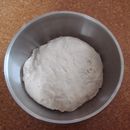
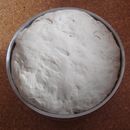

Many breads are leavened by yeast. The yeast used for leavening bread is Saccharomyces cerevisiae, the same species used for brewing alcoholic beverages. This yeast ferments carbohydrates in the flour, including any sugar, producing carbon dioxide. Most bakers in the U.S. leaven their dough with commercially produced baker's yeast. Baker's yeast has the advantage of producing uniform, quick, and reliable results, because it is obtained from a pure culture. Many artisan bakers produce their own yeast by preparing a 'growth culture' which they then use in the making of bread. This culture kept in the right conditions will continue to grow and provide leavening for many years.
Both the baker's yeast and the sourdough method of baking bread follow the same pattern. Water is mixed with flour, salt and the leavening agent (baker's yeast or sourdough starter). Other additions (spices, herbs, fats, seeds, fruit, etc.) are not necessary to bake bread, but are often used. The mixed dough is then allowed to rise one or more times (a longer rising time results in more flavor, so bakers often punch down the dough and let it rise again), then loaves are formed, and (after an optional final rising time) the bread is baked in an oven.
Many breads are made from a straight dough, which means that all of the ingredients are combined in one step, and the dough is baked after the rising time. Alternatively, dough can be made using a pre-ferment, when some of the flour, water, and the leavening are combined a day or so ahead of baking, and allowed to ferment overnight. On the day of the baking, the rest of the ingredients are added, and the rest of the process is the same as that for straight dough. This produces a more flavorful bread with better texture. Many bakers see the starter method as a compromise between the highly reliable results of baker's yeast, and the flavor/complexity of a longer fermentation. It also allows the baker to use only a minimal amount of baker's yeast, which was scarce and expensive when it first became available. Most yeasted pre-ferments fall into one of three categories: poolish or pouliche, a loose-textured mixture composed of roughly equal amounts of flour and water (by weight); biga, a stiff mixture with a higher proportion of flour; and pâte fermentée, which is simply a portion of dough reserved from a previous batch. Sourdough (also known as levain or "natural leaven") takes it a step further, creating a pre-ferment with flour and water that propagates naturally occurring yeast and bacteria (usually Saccharomyces exiguus, which is more acid-tolerant than S. cerevisiae, and various species of Lactobacillus.)
Sourdough
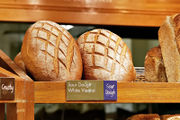
The sour taste of sourdoughs actually comes not from the yeast, but from a lactobacillus, with which the yeast lives in symbiosis. The lactobacillus feeds on the byproducts of the yeast fermentation, and in turn makes the culture go sour by excreting lactic acid, which protects it from spoiling (since most microbes are unable to survive in an acid environment). All yeast-leavened breads used to be sourdoughs, and the leavening process was not understood until the 19th century, when with the advance of microscopes, scientists were able to discover the microbes that make the dough rise. Since then, strains of yeast have been selected and cultured mainly for reliability and quickness of fermentation. Billions of cells of these strains are then packaged and marketed as "Baker's Yeast". Bread made with baker's yeast is not sour because of the absence of the lactobacillus. Bakers around the world quickly embraced baker's yeast for it made baking simple and so allowed for more flexibility in the bakery's operations. It made baking quick as well, allowing bakeries to make fresh bread from scratch as often as three times a day. While European bakeries kept producing sourdough breads, in the U.S., sourdough baking was widely replaced by baker's yeast, and only recently has that country (or parts of it, at least) seen the rebirth of sourdough in artisan bakeries. According to Alton Brown, host of Food Network's Good Eats television show, each region of the world has different strains of lactobacillus, hence the flavor of the bread made from home starters is unique. The San Francisco Bay Area is especially famous for its sourdough breads.
Sourdough breads are most often made with a sourdough starter (not to be confused with the starter method discussed above). A sourdough starter is a culture of yeast and lactobacillus. It is essentially a dough-like or pancake-like flour/water mixture in which the yeast and lactobacilli live. A starter can be maintained indefinitely by periodically discarding a part of it and refreshing it by adding fresh flour and water. (When refrigerated, a starter can go weeks without needing to be fed.) There are starters owned by bakeries and families that are several human generations old, much revered for creating a special taste or texture. Starters can be obtained by taking a piece of another starter and growing it, or they can be made from scratch. There are hobbyist groups on the web who will send their starter for a stamped, self-addressed envelope, and there are even mailorder companies that sell different starters from all over the world. An acquired starter has the advantage of being more proven and established (stable and reliable, resisting spoiling and behaving predictably) than from-scratch starters.
There are other ways of sourdough baking and culture maintenance. A more traditional one is the process that was followed by peasant families throughout Europe in past centuries. The family (usually the woman was in charge of breadmaking) would bake on a fixed schedule, perhaps once a week. The starter was saved from the previous week's dough. The starter was mixed with the new ingredients, the dough was left to rise, then a piece of it was saved (to be the starter for next week's bread). The rest was formed into loaves which were marked with the family sign (this is where today's decorative slashing of bread loaves originates from), and taken to the communal oven to bake. These communal ovens over time evolved into what are known today as bakeries, when certain people specialized in bread baking, and with time enhanced the process so far as to be able to mass produce cheap bread for everyone in the world.
Steam leavening
The rapid expansion of steam produced during baking leavens the bread, which is as simple as it is unpredictable. The best known steam-leavened bread is the popover. Steam-leavening is unpredictable since the steam is not produced until the bread is baked.
Steam leavening happens regardless of the rising agents (baking soda, yeast, baking powder, sour dough, beaten egg whites, etc.)
- The leavening agent either contains air bubbles or generates carbon dioxide.
- The heat vaporises the water from the inner surface of the bubbles within the dough.
- The steam expands and makes the bread rise.
It is actually the main factor in the rise of bread once it has been put in the oven. CO2 generation, on its own, is too small to account for the rise. Heat kills bacteria or yeast at an early stage, so the CO2 generation is stopped.
Bacterial leavening
Salt rising bread employs a form of bacterial leavening that does not require yeast. Although the leavening action is not always consistent, and requires close attention to the incubating conditions, this bread is making a comeback due to its unique cheese-like flavor and fine texture.[7]
Aeration
Aerated bread is leavened by carbon dioxide being forced into dough under pressure. The technique is no longer in common use, but from the mid 19th to 20th centuries bread made this way was somewhat popular in the United Kingdom, made by the Aerated Bread Company and sold in its high-street tearooms.
Fats or shortenings
Fats such as butter, vegetable oils, lard, or that contained in eggs affects the development of gluten in breads by coating and lubricating the individual strands of protein and also helping hold the structure together. If too much fat is included in a bread dough, the lubrication effect will cause the protein structures to divide. A fat content of approximately 3% by weight is the concentration that will produce the greatest leavening action . In addition to their effects on leavening, fats also serve to tenderize the breads they are used in and also help to keep the bread fresh longer after baking.
Bread improvers
Bread improvers are frequently used in the production of commercial breads to reduce the time that the bread takes to rise, and to improve the texture and volume of bread. Chemical substances commonly used as bread improvers include ascorbic acid, hydrochloride, sodium metabisulfate, ammonium chloride, various phosphates, amylase, and protease.
Sodium/salt is one of the most common additives used in production. In addition to enhancing flavor and restricting yeast activity, salt affects the crumb and the overall texture by stabilizing and strengthening[8] the gluten. Some artisan bakers are foregoing early addition of salt to the dough, and are waiting until after a 20 minute "rest." This is known as an autolyse,[9] and is done with both refined and with whole grain flours.
Bread baking
| Baking of bread | ||
|---|---|---|
|
1/12
|
2/12
|
3/12
|
|
4/12
|
5/12
|
6/12
|
|
7/12
|
8/12
|
9/12
|
|
10/12
|
11/12
|
12/12
|
The serving of bread
Bread can be served at any temperature. Once baked, it can subsequently be toasted. It is most commonly eaten with the hands, or sometimes with a knife and fork. It can be eaten by itself or as a carrier for another, usually less compact food. Bread may be dipped into a liquid (such as gravy, olive oil, or sardine pâté), topped with various spreads, both sweet and savory, or serve as the enclosure for the ubiquitous sandwich with any number of varieties of meat, cheese, vegetables or condiments inside.
Bread crust
The bread crust is formed from exposed dough during the cooking process. It is hardened and browned through the Maillard reaction using the sugars and amino acids and the intense heat at the bread surface. The nature of a bread's crust differs depending on the type of bread and the way it is baked. Commercial bread is baked using jets that direct steam towards the bread to help produce a desirable crust. Bread crusts are sometimes considered unpalatable, especially and notoriously by young children, who commonly remove and throw away the crusts. Some manufacturers, such as Sara Lee, have begun to market special crust-less breads. But for many, crusts are part of the allure of a delicious loaf of bread.
Breads across different cultures
Being the simplest, cheapest and most basic type of food, bread is often referred as a synecdoche for "food" in general, in some languages and dialects, such as Greek and Punjabi. There are many variations on the basic recipe of bread worldwide, including pizza, chapatis, tortillas, baguettes, brioche, pitas, lavash, biscuits, pretzels, naan, bagels, puris, and many others.
- In Mexico bread is called pan (Spanish for bread). Although corn tortillas are the staple bread in most of Mexico, breadrolls in many varieties are an important daily food for city dwellers. Popular breads in Mexico include the bolillo roll and pan dulce. There are many varieties, about 1,000. Pan dulce, which is Spanish for "sweet bread", is primarily eaten at breakfast.
- In Peru, pan has many variations due to the diversity of Peruvian cuisine. People usually eat Pan de piso, and Pan serrano. There are also some kind of bread made of potatoes, currently popular in the Andes. Bizcochos are sweet bread usually eaten with some butter and hot chocolate. A dough made with cooked pumpkin or squash, often shaped and fried into doughnuts and served with a sweet fruity dipping sauce, is a traditional favorite.
- In Spain bread is called pan. There is a region called Tierra del Pan (literally translated as "Land of the Bread"), located in the province of Zamora, where economy was in the past joined to this activity.
- In South Asia ( India, Pakistan, Middle East, etc.), roti or chapati, types of unleavened flat breads usually made from wholewheat flour and baked on a hot iron griddle called a tava, form the mainstay of the peoples' diet. Rotis and naans are usually served with curry throughout the region. A variant called makki di roti uses maize flour rather than white flour. Another variant is puri, a thin flat bread which is fried rather than baked and puffs up while cooked. Paratha is another variation on roti. Naan (leavened wholewheat bread), however, is baked in a tandoor or clay oven and is rarely prepared at home. White and brown breads are also very common, but not as much as roti.
- In the Philippines, pandesal (or pan de sal; literally, bread of salt or salt bread) is a rounded bread usually eaten by Filipinos during breakfast.
- Germany prides itself on having the largest variety of breads worldwide. More than 300-500 basic kinds of bread come together with more than 1,000 types of small bread-rolls and pastries. It has been estimated that the basic kinds of bread are so widely varied by more than 16,000 local bakeries that more than 1,000 different breads have been presented at a 2005 Cologne bread show.[10] Germans are worldwide the biggest consumers (per capita) of bread followed by Chile.[11]
- In Scandinavian and Nordic countries, four grain types dominated in the prehistoric era (prior to 1000 AD). Barley and rye are the oldest; wheat and oats are more recent. During the Iron Age (500 AD–1050 AD), rye became the most commonly used grain, followed by barley and oats. Scandinavian soldiers apparently learned baking techniques while working as mercenaries in the Roman army (200–400 AD). They subsequently took the technique home with them as a way to show that they had been employed in high-status work on the continent. Early Christian traditions promoted an interest in bread. Rye was also the most commonly used grain for bread up until the beginning of the 20th century. Today, older grain types such as emmer and spelt are once again being cultivated and new bread types are being developed from these grains. Culturally, Germany has influenced most of the bread types in the Nordic countries. However, in the eastern part of Finland, there is a cultural link to Russia and Slavic bread traditions.
- In the late 19th century, Danish bakers in the larger towns baked fresh bread in the morning. This bread, called morgenbrød, primarily made from wheat and intended for the rising bourgeoisie, was baked into various shapes and with a variety of seasonings. Since then, this freshly-baked bread has been produced in every Danish baker's shop, along with a variety of other breads. This decentralised form of baking bread alongside the more modern industrialised production of bread seems to be characteristic of the Danish bread sector. Consumption, to a great extent, has switched from rye bread to wheat bread.
- Finland and Russia both have dark, sourdough breads made of rye. Traditional Finnish rye bread is disc-shaped, with a hole in the center for easier storing. These breads have a rougher composition and a stronger taste than wheat bread, and can thus be stored for longer periods of time. Some families may still have leaven, handed down from one generation to the next, that they use for baking these breads. . Bread is made from all four of the cereals grown in Finland: wheat, rye, barley and oats; these are usually ground into various grades. Rye bread can be either light or dark in colour, depending on the type of flour mixture used. A few wheat breads are still made in Finland, although most are simple buns or loaves of sliced or unsliced bread. Vesirinkeli (water rings), are small, almost tasteless rings of yeast-leavened wheat bread, which resemble bagels. The potato, although a late introduction to Finland in the early 19th Century, features heavily in food culture and has found its way into many kinds of bread.
- With the settlement Iceland circa 800–900 AD, grain, in the form of barley was brought, cultivated and used for bread and porridge. Grain cultivation is thought to have been abandoned before 1600 due to harsher climatic conditions, and subsequently most grains such as barley and rye were imported. The scarcity of grain was overcome in different ways in different parts of the country. In some areas, grain was made to go further using dulse (Palmaria palmata; Icelandic söl), Iceland Moss (Cetraria islandica; Icelandic fjallagrös) or Irish Moss (Chondrus crispus; Icelandic fjörugrös) in compotes and breads. It was not until the 18th century that it became common practice to make leavened rye breads; sourdough was mostly used. Rye breads baked in hot springs are a popular item today, and are served for local consumption as well as for tourists. In general, stock fish (harðfiskur) was served as a bread substitute, eaten with butter on the side with almost every meal. Today, it is a popular snack which has found a new target group within the sports food market due to its high protein and favourable amino acid content. Most types of breads available in other Western countries are now also available in Iceland, either baked in Iceland or imported. Everyday bread is mostly made by industrial bakeries or at the local bakery. Of the bread types currently available, flatbrauð (flatbread) and laufabrauð (leaf bread) have the longest history.
- Many new types of bread have reached the markets in Norway in recent years. A high percentage of people reported regularly eating bread types such as spelt, specialty, gourmet, and fibre/bran bread, as well as ciabattas and baguettes, although very few reported doing so on a daily basis. Norwegian bakers now have competition from abroad. The wholegrain bread from local bakers must give way to huge lorry loads of baguettes and frozen dough offering cheaper products. Flatbread is still a very popular bread type.
- In Sweden, during the transion to a modern urban and industrialised society (19th century AD), bread types changed when large industrial bakeries introduced new soft bread. From from the early 1920s, these were often sweetened. From then on, bread was bought from stores and bakeries, rather than baked at home, as had previously been the case. Regional variation decreased due to the transportation and marketing of bread as a national product. The consumption of bread products of various kinds has increased since the 1990s, and wholegrain bread and wheat bread are the most popular. Many older bread types still exist alongside the newer varieties.
- In Britain there is a wide variety of traditional breads, often baked in a rectangular tin. One such type of traditional bread is known as a stottie cake. This is a thick, flat, round loaf that is common in North East England.
- In Scotland, another form of bread called plain bread is also consumed. Plain bread loaves are noticeably taller and thinner, with burned crusts at only the top and bottom of the loaf. Plain bread has a much firmer texture than English and American pan bread. Plain bread is becoming less common as the bread consumed elsewhere in Britain is becoming more popular with consumers.
- In Ireland, it is traditionally held that the end of a loaf of bread (the 'heel' or 'hilt' of the loaf) is the best part of the loaf. Other stories and myths surround this piece of the bread in Irish Mythology. Irish soda bread, developed to make the most of the soft wheat grown in Ireland, is unusual for a European bread in that it is a quick bread, using the reaction of buttermilk and baking soda rather than yeast to rise.
- In France, pan bread is known as pain de mie and is used only for toast or for making stuffing; standard bread (in the form of baguettes or thicker breads) has a thick crust and often has large bubbles of air inside. It is often baked three times daily and is sold totally unwrapped for a crisp crust. Some fancy breads contain walnuts or are encrusted with poppy seeds.
- Due to its long history of regional political division, Italy specializes in many different kinds of bread, reflecting its great regional variation and widely different breadmaking recipes and traditions. As a rule of thumb, rolls are typical of the northern regions, while large loaves are typical of the southern regions. Bread often has a small quantity of olive oil, butter, or rendered lard mixed into the dough to make it softer and more palatable. Traditional rustic breads include sfilatino imbottito (a stuffed bread roll) and pizza bianca (a flat white bread).[12] Focaccia is quite popular in Italy and southern France. In Provence, it is known as fougasse or fouace, with the former becoming increasingly common. Fougasse can now be bought all over France. It is usually seasoned with olive oil and herbs, and often either topped with cheese or stuffed with meat or vegetables. Focaccia doughs are similar in style and texture to pizza doughs.
- In the United States, traditional breads include cornbreads and various quick breads, such as biscuits. Cornbread is made from cornmeal and can differ significantly in taste and texture from region to region. The South generally prefers white cornmeal with little to no wheat flour or sweeteners added. It is traditionally baked in a cast-iron skillet and ideally has a crunchy outside and moist inside. The North, however, usually prefers yellow cornmeal with sometimes as much as half wheat flour in its composition, as well as sugar, honey, or maple syrup. This results in a bread that is softer and sweeter than its southern counterpart. Homemade wheat breads are made in a rectangular tin similar to those in the United Kingdom. Rolls, made from wheat flour and yeast, are another popular and traditional bread, eaten with the dinner meal. Sourdough biscuits are traditional "cowboy food" in the West. The San Francisco Bay Area is known for its crusty sourdough. Spoon bread, also called batter bread or egg bread, is made of cornmeal with or without added rice and hominy, and is mixed with milk, eggs, shortening and leavening to such a consistency that it must be served from the baking dish with a spoon. This is chiefly popular in the South. Up until the 20th century (and even later in certain regions), any flour other than cornmeal was considered a luxury; this would explain the greater variety in cornbread types compared to that of wheat breads. Commercially, the most popular bread has been a soft-textured type with a thin crust that is usually made with milk and is slightly sweet; this is the type that is generally sold ready-sliced in packages. It is usually eaten with the crust, but some eaters or preparers may remove the crust due to a personal preference or style of serving, as with finger sandwiches served with afternoon tea. Some of the softest bread, including Wonder Bread, is referred to as "balloon bread". Though white "sandwich bread" is the most popular, Americans are trending towards more artisanal breads. Different regions of the country feature certain ethnic bread varieties including the French baguette, the Ashkenazi Jewish bagel, scali (an Italian-style bread made in New England), Native American frybread (a product of hardship, developed during the Indian resettlements of the 19th century), and Jewish rye, a bread commonly associated with delicatessen cuisine.
- Christian traditional societies (usually in poor communities), used to respect bread since Jesus symbolised his body with it. The sign of the cross was performed with the knife on the bread's surface, before the loaf was cut. Sometimes it was considered a sin to desecrate bread (e.g., throw it away).
- Jews have traditionally baked challah, a type of egg bread with a thin, hard crust and a soft, well-leavened center. It is made by wrapping plaits of dough and then lightly baking them in an oven. Challah is sometimes sweetened using honey and sometimes includes raisins. During Passover, unleavened bread, in the form of various types of matzo, is required due to the Biblical injunction to avoid any form of leaven during this time of year. There is some debate within the Jewish community as to whether dairy products are allowed in kosher bread; some authorities maintain that bread must be strictly pareve to avoid combining meat and dairy in the same meal, while others feel it is acceptable as long as a sign of some sort (usually a different loaf shape, but others are known) is baked into the loaf to distinguish it from pareve bread.
- In Morocco and West North Africa, a round bread which is roughly four inches tall is used to eat most of the Mediterranean's watery cuisine. They also have a thick and chewy fried bread which is smothered in oil beforehand. The rghifa bread is a staple in Morocco's food and consists of several layers of lightly cooked bread.
- In China, the traditional bread is Mantou. It is made by steaming or deep frying dough made from either wheat flour or rice. In Northern China, Mantou is often eaten as an alternative staple to rice. Steamed Mantou is similar to western white bread, but since it is not baked, it does not have a brown outer crust. Mantou that have a filling such as meat or vegetables (Char Siu Bao, for example) are called "baozi".
- There are different types of traditional 'cheese breads' in many countries, including Brazil, Colombia, Italy and Russia.
 Challah |
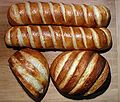 Four loaves |
 Pain au Levain, a French bread |
 Breads and Bread rolls at a bakery |
 Tin Vienna bread |
Bread in a traditional oven |
 Pre-sliced bread |
 Bread rolls |
 Close up of sourdough bread slice |
 A selection of breads |
 Crustless bread covered by a mold |
|
|
Homemade rye bread |
 A variety of breads at the Boudin Bakery. |
 Sourdough breads like this baguette (left) and roundbread begin with a starter passed down from excess batter from a previous loaf. |
 A chef in India prepares Rumali Roti |
 Bread-seller in front of a bakery, Damascus, 1910. |
 A variety of bread in Stroud Farmers' market, England |
 Slice of French Bread. |
See also
- Bread clip
- Culinary arts
- Breadmaking ingredients, techniques and tools
- Baker percentage
- Baker's yeast
- Bread machine
- Bread pan
- Quick bread
- Sliced bread
- Culinary uses
- Breadcrumbs
- Breading
- Sop
- Croutons
- Bread Bowl
- Stuffing
- Toast
- Melba toast
- Types of bread
|
|
References
- ↑ McGee, p. 517
- ↑ Tannahill p. 68-69
- ↑ Cockney Rhyming Slang
- ↑ "Russia. Britannica". Britannica.com. http://www.britannica.com/EBchecked/topic/513251/Russia/38557/The-Civil-War-and-War-Communism-1918-21. Retrieved 2010-06-03.
- ↑ "Vladimir Lenin: From March to October. SparkNotes". Sparknotes.com. http://www.sparknotes.com/biography/lenin/section6.rhtml. Retrieved 2010-06-03.
- ↑ CBS Interactive Inc. White Bread In Wheat Bread's Clothing CBS Early Show. Retrieved June 14, 2008.
- ↑ "Susan R. Brown’s Salt Rising Bread Project". Home.comcast.net. http://home.comcast.net/~petsonk/. Retrieved 2010-06-03.
- ↑ Nancy Silverton, Breads From The La Brea Bakery (1996), Villard
- ↑ Peter Reinhart, The Bread Baker's Apprentice: Mastering the Art of Extraordinary Bread (2001), Ten Speed Press
- ↑ "Bread World Record (in German)" (PDF). http://web.archive.org/web/20080627014345/http://www.biv-rheinland.de/Brotweltrekord/BWR_WDR-TV_140905.pdf. Retrieved 2010-06-03.
- ↑ [1]
- ↑ [2]
Bibliography
- Kaplan, Steven Laurence: Good Bread is Back: A Contemporary History of French Bread, the Way It Is Made, and the People Who Make It. Durham/ London: Duke University Press, 2006. ISBN 9780822338335
- Jacob, Heinrich Eduard: Six Thousand Years of Bread. Its Holy and Unholy History. Garden City / New York: Doubleday, Doran and Comp., 1944. New 1997: New York: Lyons & Burford, Publishers (Foreword by Lynn Alley), ISBN 1-55821-575-1 <
- Spiekermann, Uwe: Brown Bread for Victory: German and British Wholemeal Politics in the Inter-War Period, in: Trentmann, Frank and Just, Flemming (ed.): Food and Conflict in Europe in the Age of the Two World Wars. Basingstoke / New York: Palgrave, 2006, pp. 143–171, ISBN 1-4039-8684-3
- Tannahill, Reay (1973). Food in History. Stein and Day. ISBN 0-8128-1437-1.
- Cunningham, Marion (1990). The Fannie Farmer cookbook. illustrated by Lauren Jarrett (13th edition ed.). New York: Alfred A. Knopf. ISBN 0-394-56788-9.
- Trager, James (1995). The food chronology: a food lover's compendium of events and anecdotes from prehistory to the present. Henry Holt. ISBN 0-8050-3389-0.
- Davidson, Alan (1999). The Oxford Companion to Food. Oxford University Press. ISBN 0-19-211579-0.
- McGee, Harold (2004). On food and cooking. Scribner. ISBN 0-684-80001-2.
- D. Samuel (2000). "Brewing and baking". Ancient Egyptian materials and technology. Eds: P.T. Nicholson & I. Shaw. Cambridge: Cambridge University Press. pp. 537–576. ISBN 0-521-45257-0.
- Pyler, E. J. (1988). Baking Science & Technology 3rd Ed. vols. I & II. Sosland Publishing Company. ISBN 0-929005-02-3.
External links
|
|||||||||||||||||||||||||||||
|
||||||||||||||||||||||||
|
|||||||||||||||||||||||||||||||||||
